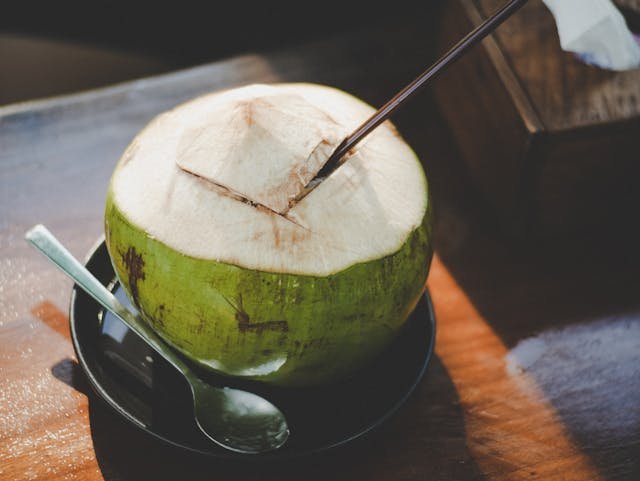5 Ways to Open and Drink from a Coconut
Opening and enjoying a coconut can be a delightful experience, offering a refreshing sip of its naturally hydrating water. Whether you opt for the traditional machete method, utilize specialized coconut opener tools, or explore creative approaches like freezing, each method brings its flair to the process. However, safety remains paramount, especially when handling sharp tools. This comprehensive guide outlines various techniques, ensuring you can confidently open a coconut and relish its invigorating water while maintaining caution and precision.
Select a coconut for water consumption

For coconut water, young coconuts, also known as green coconuts, are considered the best choice. These coconuts are harvested at an earlier stage of maturity, typically around 5 to 7 months. Here’s why young coconuts are preferred for coconut water:
Higher Water Content
Young coconuts contain more water compared to mature coconuts. The water inside is clear, slightly sweet, and has a refreshing taste.
Soft and Tender Flesh
The flesh of young coconuts is softer and more tender, making it easier to scoop out if desired. However, the primary focus is on the abundant and hydrating water.
Milder Flavor
The water from young coconuts generally has a milder flavor, making it a popular choice for drinking directly or using in beverages and smoothies.
Rich in Electrolytes
Coconut water from young coconuts is known for being rich in electrolytes, such as potassium, making it a natural and hydrating alternative to commercial sports drinks.
So, when selecting a coconut for water consumption, look for green coconuts with a smooth, green outer husk. These coconuts are often available at grocery stores or markets, and they can be easily identified by their youthful appearance and lighter weight compared to mature coconuts. Now let’s learn the ways to open a coconut for water.
Methods to Open and Drink From a Coconut

Method 1. Using a Machete or Cleaver
- Begin by holding the coconut firmly with one hand, and with the other hand, grasp a machete or cleaver.
- Position the blade at the top (pointed end) of the coconut.
- With caution, deliver firm and careful strikes to the coconut while rotating it. This action is to create a hole in the top.
- Continue striking until the top is open, exposing the coconut water.
- You can either drink the coconut water directly from the hole or use a straw for a more controlled sip.
Method 2. Using a Coconut Opener Tool
- Coconut opener tools are specialized instruments designed for this purpose.
- Place the tool on the top of the coconut, ensuring it aligns with one of the eyes.
- Twist the tool until it pierces through the coconut’s shell.
- Remove the tool, leaving behind a clean hole through which you can drink the coconut water using a straw.
Method 3. Drilling a Hole
- Use a power drill equipped with a clean drill bit.
- Drill a hole into one of the coconut’s eyes, applying steady and gentle pressure.
- Tilt the coconut over a container to collect and let the water drain out.
- Once drained, you can either drink directly from the hole or use a straw for a more controlled experience.
Method 4. Smashing on a Hard Surface
- Hold the coconut securely over a hard surface.
- Strike the coconut forcefully along its equator using a hammer or a heavy object.
- Continue striking until the coconut cracks open, revealing both coconut water and pulp.
- Collect the coconut water for drinking or use it in recipes.
Method 5. Freezing and Cracking
- Place the whole coconut in the freezer for a few hours.
- Remove the coconut and tap it on a hard surface to create cracks in the shell.
- Separate the coconut into halves, allowing access to the coconut water and flesh.
- Drink the coconut water directly from the shell or use a straw.
Safety Tips While Opening a Coconut

Secure Grip
Ensure a firm grip on the coconut to prevent accidental slips. Hold it steady, especially when using tools.
Use Protective Gear
Wear protective gloves to shield your hands from potential cuts or abrasions, particularly when handling sharp tools like machetes or cleavers.
Choose a Stable Surface
Place the coconut on a stable and non-slip surface to prevent it from rolling or moving during the opening process.
Mindful Strikes
If using a machete or cleaver, strike with controlled force and precision. Avoid overly aggressive swings to minimize the risk of accidents.
Position Tools Properly
Align your tools carefully, ensuring they are pointed away from your body and limbs to prevent unintentional injuries.
Mind the Eyes
Be cautious when piercing the coconut’s eyes. Aim for the softest one and apply gentle pressure to avoid slippage.
Protective Eyewear
Consider wearing protective eyewear to shield your eyes from any debris that may scatter during the opening process.
Stable Stance
Maintain a stable and balanced stance to enhance control and reduce the likelihood of losing balance.
Know Your Skill Level
Choose a method that aligns with your skill level. If you’re unfamiliar with certain tools, seek guidance or opt for safer alternatives.
First Aid Kit
Keep a first aid kit nearby with basic supplies in case of minor injuries. Promptly treat any cuts or abrasions to prevent infections.
Takeaway Note
As you embark on your coconut-opening journey, remember that safety comes first. Whether you choose the classic machete, a specialized opener, or get creative with freezing, the goal is to savor the pure and hydrating coconut water. Embrace the diverse methods, but always exercise caution when using tools. Once opened, revel in the pleasure of sipping directly from the coconut or incorporating its water into culinary delights, making each coconut experience a satisfying and safe adventure.
